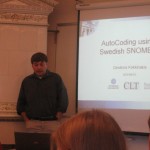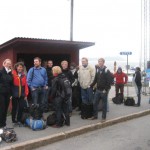The site shows some examples of how business models can be applied in health care. Each business model is described in terms of problems that they solve, existing examples of their use, and a short discussion of drawback and benefits with the model. Drawback and benefits of each model are described by linking to a set of values derived from existing quality frameworks.
– Take a look at http://dsv.su.se/vippa (site in swedish)
The site is developed as a part of the VIPPA project.
The Swedish Research School of Management and IT (MIT) – seminar at Uppsala University
As members of The Swedish Research School of Management and IT (MIT) Edephonce Nfuka and I have participated between 5 to 7th October 2010 to the MIT seminar at Uppsala University. Here we have presented a research paper named “The effect of critical success factors on IT governance performance in the public sector organizations from a developing country: A case of Tanzania”. The paper has well been received and the comments we have got from the participants to this seminar will due to an improvement of our paper that has been targeted to be submitted for publication to a journal. The MIT seminar from this year was also an opportunity to attend different paper presentations and make constructive comments to the authors for the improvement of their papers. Moreover in the MIT seminar from Uppsala University we have attended three interesting lectures done by Professor John Kimberly from The Wharton School, University of Pennsylvania. For more information about The Swedish Research School of Management and IT (MIT) please access the following link: http://www.mit.uu.se/
A new article on Anchor Modeling
After the Best paper award at the ER 2009 conference, we got invitation to write a journal article on Anchor Modeling. The title of the new article is “Anchor Modeling – Agile Information Modeling in Evolving Data Enviornmnets”. The authors are Lars Rönnbäck (Resight), Olle Regardt (Teracom), Maria Bergholtz (DSV), Paul Johannesson (DSV) and I. The article has now been accepted for publication in the journal Data and Knowledge Engineering (DKE, Elsevier). A preprint of it can be found here.

Abstract: Maintaining and evolving data warehouses is a complex, error prone, and time consuming activity. The main reason for this state of aairs is that the environment of a data warehouse is in constant change, while the
warehouse itself needs to provide a stable and consistent interface to information spanning extended periods
of time. In this article, we propose an agile information modeling technique, called Anchor Modeling, that
oers non-destructive extensibility mechanisms, thereby enabling robust and exible management of changes.
A key benet of Anchor Modeling is that changes in a data warehouse environment only require extensions,
not modications, to the data warehouse. Such changes, therefore, do not require immediate modications of
existing applications, since all previous versions of the database schema are available as subsets of the current
schema. Anchor Modeling decouples the evolution and application of a database, which when building a
data warehouse enables shrinking of the initial project scope. While data models were previously made
to capture every facet of a domain in a single phase of development, in Anchor Modeling fragments can
be iteratively modeled and applied. We provide a formal and technology independent denition of anchor
models and show how anchor models can be realized as relational databases together with examples of
schema evolution. We also investigate performance through a number of lab experiments, which indicate that
under certain conditions anchor databases perform substantially better than databases constructed using
traditional modeling techniques.
Keywords: Anchor Modeling, database modeling, normalization, 6NF, data warehousing, agile development,
temporal databases, table elimination
Third HEXAnord Meeting, Utö 22-24 September 2010
The Master Programme in Health Informatics with Karolinska Institute has started
Now the Master Programme in Health Informatics with Karolinska Institute has started.
SISA – Svenska informationssystemsakademin

Aron Henriksson, new employee
Hi!
I have been working full-time at DSV for a month now and would like to take the opportunity to introduce myself on the Syslab blog. I’m currently working on adapting the Web Mining course to a more distance-friendly form. I will also be involved in the research work of the “IT for Health” team, performing natural language processing on patient health records.
I have a BSc in computer science from RMIT in Melbourne, Australia and I just recently completed my Master’s degree from KTH and the EMIS program. In my thesis I explored the possibility of applying the automatic classification methods (corpus annotation and machine learning) used in the biomedical and clinical domain to that of knowledge management. More specifically, I wanted to find out whether it is possible to assess automatically the level of certainty in knowledge-intensive documents. Together with my supervisor, Sumithra Velupillai, the thesis was turned into a paper that was published and presented at a workshop (Negation and Speculation in Natural Language Processing) in Uppsala in July.
I look forward to getting to know you all more in the coming months!
Aron




